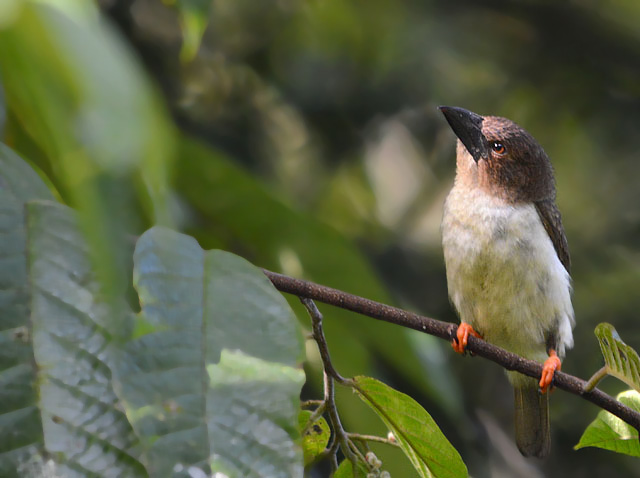I
found myself with a Saturday morning to kill and decided to take a ride up
north to the pristine jungle of Bukit Wang in Kedah state. This was my first
long distance ride with my recently acquired iron steed and she performed up to
expectations. However, I nearly rode her into a trench as I approached the
entrance to the forest reserve. A pair of White-crowned Hornbills flew low
across the access road like oversized Magpie-Robins. It certainly took me by
surprise. By the time I safely parked her by the side of the road and geared up,
the only thing that prevented the whole episode from being just a figment of my
imagination were the distanced calls of the pair from deep inside their lush jungle
domain. It was one hell of a way to start off a birding excursion.
At
the car park area, a Grey Wagtail scurried around for breakfast along the
tarmac road. This species is a common migrant throughout the country and a locality like
this is the ideal wintering ground for it. The wagtail can be quite wary at
times but I was drawn to the pleasant colour combination that it possesses. I
was still given the evil eye despite going down on all fours to try and conceal
my human form – the thing that animals usually fear.
As
you approach the forest trail, there is a huge open area where raptors can
sometimes be seen in flight. Although there were no predatory birds around this
time, the sky was not void of birds completely. A pair of Raffles’s Malkoha
leisurely glided across and I managed to capture one of them as best as I
could. The blurry image did no justice to the female bird as she followed a few
seconds behind her mate.
Missing
the malkohas was the least of my concerns. There was something much direr that
had my undivided attention. Heaps of construction stones were scattered all
over. I noticed some upgrading works taking place at the recreational on my way
in but this was too close for comfort. Beyond the field is where the true
forest lies and the delicate balance of nature there may not be able to cope
with whatever the authorities had plan.
The
access road cutting through the forest has been widened and flattened. And when
a tractor made its way past me from the other direction, I knew that the
entire road has suffered the same fate. I can still remember the authorities so
proudly labelled this area as a virgin jungle. But now, we know the virginity of
this jungle is a thing of the past.
Bukit
Wang is not the place for you if you do not fancy getting your feet wet. With the bridge joining the recreational area to the forested area down indefinitely, my
appreciation for my rubber shoes now knows no bounds.
As
expected, not much was about due to all the commotion. I even had time to take
notice of some of Mother Nature’s less significant creations – termites. To be
more precious, they were Macrotermes Termites and are supposedly the
largest species in Southeast Asia (thank you, Google).
The
soldiers are not all looks with no bite. They are vicious and they certainly
can bite. Something I know from experience...
When
I came across a little brown job hawking for insects along the access road, I
do not think I have ever been so excited to stalk what looked like a Dark-sided
Flycatcher. When I got closer, my first assumption was dead on. This common
migrant lingered about in the sunlight and that enabled me to obtain some images
that turned out relatively well despite the distance.
The
Red-eyed Bulbul is another drab species that do not often stir much of my
emotions but today was an exception. However it was so comfortable resting
under the foliage of the forest canopy, it hardly moved throughout my
observation.
Lucky
for me, the long ride was not a total washout. My break came when I stumbled
onto a flock of Sooty Barbet feasting on a fruiting tree. I proceeded with caution
and stealth and found myself a shady spot close enough to capture this peculiar
barbet. Being different can be a good thing. And to be a barbet without any
traces of green on its plumage and squeaks like a mouse, the Sooty Barbet
certainly stands out from the rest.
The
Sooty Barbet is not uncommon here but their preference for the canopy level
makes it difficult to obtain good images. Naturally, I was relishing every
minute of this encounter while the barbets were ravishing the succulent morsels
being offered. Don’t you just love it when things fall into place perfectly?
Contemplating which bunch of fruits to feast on next...
It has a distinct chubby appearance that makes it utterly adorable. Away from the harsh morning sun, this image shows a truer colour of this forest dweller.
The
females possess light coloured bills and this girl came closest to my position
– a gesture that certainly did not go unappreciated. The whole encounter lasted
about half an hour or so. When the flock dispersed, I expected them to be back
soon but that was all for today. Reluctantly, I carried on along the forested track until fatigue overtook
enthusiasm. The ride back was slightly taxing due to the midday heat but the
encounter with the Sooty Barbets certainly made the trip worth the effort.






















































